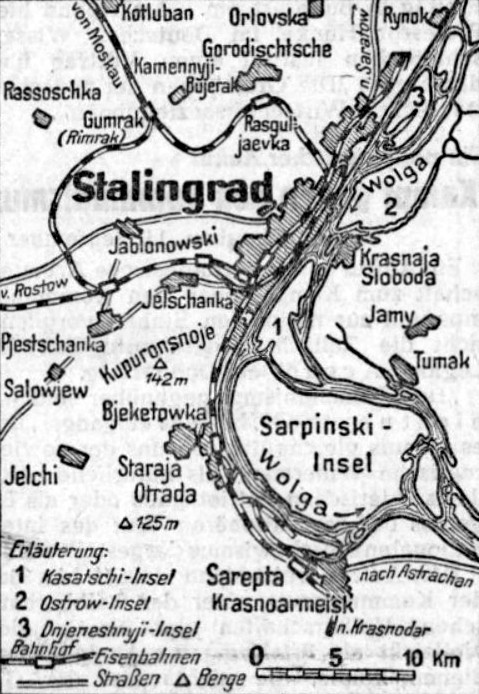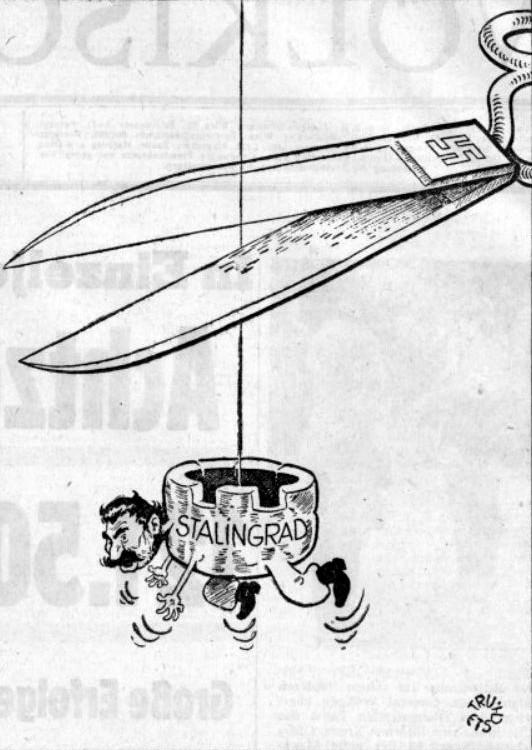The Pittsburgh Press (September 14, 1942)
Hordes of Nazis repulsed in Volga battle, Reds say
Reds refer to fighting ‘at Stalingrad’ for first time, but declare defenders hold in bitter hand-to-hand struggle
By M. S. Handler, United Press staff writer
Moscow, USSR –
Russians, backed by massed artillery, are beating off German hordes “at Stalingrad” with bayonets, frontline dispatches said today. For the first time in 36 hours, the enemy failed to gain.
In a German-language broadcast, the Moscow radio, heard in London, told the Nazis that:
…it’s now the middle of September – it is autumn. The rains have set in and the nights are cold. But Stalingrad still stands.
A dispatch to the Communist Party organ Pravda referred to “fighting at Stalingrad,” and said that the Germans had been repulsed in bitter hand-to-hand fighting on one sector, where they had lost 1,000 men. Previously, all dispatches had spoken of battles “west,” “southwest” or “northwest” of Stalingrad.
The Germans claimed yesterday that they had penetrated into the southern part of Stalingrad.
Tanks restore lines
The Soviet noon communiqué reported fighting west and southwest of Stalingrad and the Volga River line, and said the Germans had broken through on one southwestern sector, but Russian tanks had charged and restored the situation.
It said:
West of Stalingrad, our troops were engaged in defensive fighting with enemy infantry and tanks. The Hitlerites attacked one position with 20 tanks and two battalions of infantry. Soviet artillery and tankbusters destroyed seven tanks and forced the remainder to turn back. Enemy infantry was routed by a Soviet attack, and left 200 dead on the battlefield.
Southwest of Stalingrad, our troops continued intense fighting with the enemy. On one sector, the enemy succeeded in breaking through our positions. A Soviet tank unit attacked the enemy and restored the situation. Five German tanks, 11 armored cars and one company of infantry were destroyed.
Decision expected soon
The German general attack, in progress since last Wednesday, was probably the greatest they ever had attempted, and it was believed here that a decision would not be long coming, that the Nazi assault would collapse from the weight of fearful casualties, or Stalingrad’s gallant defenders would soon be fighting from the ruined houses of their “Soviet Verdun.”
The last German gain was reported in last midnight’s Soviet communiqué. On the southwestern approach, the Russians had to give up a village. The Germans paid for it – 3,000 men, 40 tanks and 24 trucks loaded with automatic riflemen.
It was the third Russian withdrawal on the Stalingrad Front in the 36 hours prior to last midnight. The two other retreats had been on the southwestern and western approaches.
Hungarians lost heavily
Heavy fighting flared up on the west bank of the Don, south of Voronezh. Voronezh is on the upper stretches of the Don, and was the first city on the river that the German legions reached in the summer campaign. Frontline dispatches reported that the Hungarians had lost 7,000 men in two days in fruitless attacks against Russian bridgeheads.
A Hungarian division lost 5,000 men – a third of its strength – the first day it attacked.
One hundred tanks supported the enemy in his first attacks, but failed to break Russian positions. On the second day, 47 tanks opened the attack on one sector, but ran into a minefield, and many of them were blown up.
Forty tanks attacked on another sector. Anti-tank guns knocked out seven of them and drove back the rest.
The Russians attack
Nevertheless, the Hungarian infantry continued to attack. Then the Russians took the initiative and threw a big force across to the west bank to support units holding important heights.
Crossing minefields, the Russians forced the enemy to retreat. Advanced Russian artillery intercepted motorized enemy reinforcements and destroyed 64 truckloads of troops.
The Russian offensive in the Sinyavino area of the Volkhov Front, designed to break out a land passage to besieged Leningrad, steadily gained.
The Soviet communiqué said:
Our detachments under Ushinsky pierced strongly fortified enemy defenses and occupied a locality. The enemy lost up to 1,000 men. Attempting to recapture their positions, the enemy made several unsuccessful counterattacks and suffered new losses.
Nazis trapped in Caucasus
Pravda emphasized favorable developments on the south bank of the Terek River, to which the Germans had crossed in the Mozdok area of the Eastern Caucasus in an effort to get at the oil fields of Grozny.
The fighting was in its 11th day. At first, the Germans had tried to encircle the Russians. Now it was large forces of Germans who were encircled and being exterminated. Pravda said German reinforcements had failed to break the trap.
The Berlin correspondent of a Stockholm newspaper wrote that the Russians had built two pontoon bridges across the Volga, to bring up reinforcements. He said it was “rumored” that strong Soviet reinforcements had been thrown into the battle. The Russians were using a new plane – which the Germans called “Betomplane” – more heavily armored than any ever seen on the Russian front.
German-controlled Radio Paris said Joseph Stalin had sent Marshals Semyon Timoshenko and Kliment Y. Voroshilov to conduct the defense of Stalingrad.
Illustrative of the great air battles in progress on the Stalingrad Front was the Russian report of plane losses last week. A communiqué said that 415 German planes were destroyed. The Russians lost 281 planes.


